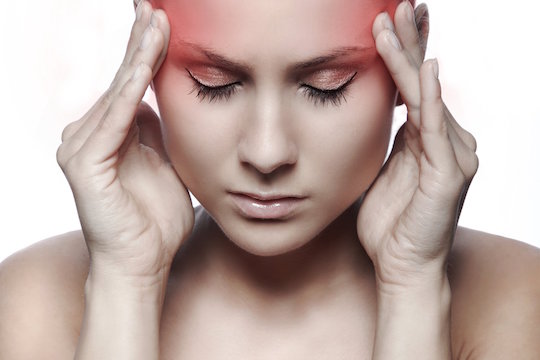10 Common Types of Headaches

There are several types of headaches (in fact, 150 diagnostic headache categories have been established) but this article is only going to cover the ten most common. Remind yourselves that although headaches are common, they are not normal, and often treatment can be just around the corner!
The most common types of headaches are:
1. Tension Headaches: Also called chronic daily headaches or chronic non-progressive headaches, tension headaches are the most common type of headaches among adults and adolescents. These muscle contraction headaches cause mild to moderate pain and come and go over a prolonged period of time. They are usually categorized into episodic or chronic.
Episodic– Generally, episodic headaches occur randomly and are often the result of temporary stress, anxiety, fatigue, or anger. They are what most of us commonly consider “tension-type” headaches. Symptoms include soreness in your temples, a tightening band-like sensation around your head (a “vice-like” ache), a pulling and pressure sensations, and contracting head and neck muscles. This is why most health care practitioners refer to tension-type headaches as “muscle contraction” headaches. Your symptoms may also include tightness in your neck and limited range of motion; only certain positions seem to provide relief. The headache surfaces in your forehead, temples, or the sub-occipital region (back of your head and neck), and often affect both sides of the head.
The best treatment option is to identify stress triggers and construct coping mechanisms. In addition, consider taking natural muscles relaxants (offered by chiropractors at the clinic.) Seeking out chiropractic, massage therapy, and acupuncture treatment is also extremely beneficial and highly recommended. If you ease or eliminate your headache with the aforementioned treatment options, your tension headaches are likely episodic in nature. If, however, you find you are receiving treatment, still feel the need to take OTC medications, and still experience headaches, please speak to your health care practitioner. You may be experiencing chronic tension-type or medication induced headaches; both aggravate and mask other headaches.
Chronic– A tension-type headache that occurs just about every day, and may have been going on for months, is chronic. It is the frequency that distinguishes episodic from chronic headaches.
2. Migraines: These head crushers are caused by inflammation of the blood vessels and arteries that wrap around the brain, which literally squeezes your brain until it hurts. Your body’s nervous system may respond with an exaggerated “fight or flight” response, albeit one that predicts you’ve lost the fight. You may feel nausea, slowed intestinal absorption, increased blood pressure, and heightened sensitivity to sensory stimuli. Because of the slowing down of your digestion process, any pain relief medications (natural or otherwise) aren’t absorbed as quickly, delaying your relief.
Migraines cause moderate to severe throbbing pain, primarily around the temple areas. The agony may last several hours or even days, and usually occur one to four times per month. Some individuals see auras, usually flashes of light that serve as warnings that a migraine is on its way. Migraines are associated with symptoms such as sensitivity to light, noise, or odours; nausea or vomiting; loss of appetite; and stomach upset or abdominal pain. When a child is having a migraine, he or she often looks pale, feels dizzy, has blurred vision, fever, stomach upset, along with the symptoms listed above.
A small percentage of children’s migraines include recurrent (cyclic) gastrointestinal symptoms, vomiting being the most common. Cyclic vomiting means that the symptoms occur on a regular basis — about once a month. These types of migraines are sometimes called abdominal migraines.
Currently, there’s no easy fix for migraines, but a variety of options does exist. Treatments include preventive and curative medicines such as natural anti-inflammatory drugs, IV Therapy, certain chiropractic techniques, IMS,and acupuncture. Although we advocate natural and holistic approaches to treatment, medical options include triptans (drugs that reduce the swelling of blood vessels on the brain), opiates, beta-blockers and antidepressants. People react in different ways to each treatment option, so keep open lines of communication with your health care provider. about what seems to be working (or not working for you). Our objective is to reduce the frequency and intensity of migraine headaches.
Genetics plays a role in migraines and there are some forms of migraines that are associated with inherited abnormalities in certain parts of the brain.
3. Mixed Headache Syndrome: Also called transformed migraines, mixed headache syndrome is a combination of migraine and tension headaches. Both adults and children experience this type of headache. While migraines are usually episodic, sometimes they become regular, unwelcome fixtures in a person’s life. When this happens, these headaches are referred to as transformed or chronic migraines. Overuse of medication may contribute to the ongoing episodes. Unfortunately, the longer you experience periodic migraines, the more likely these headaches will transform into chronic migraines.
One way to prevent them is to maintain a healthy lifestyle (proper exercise and diet) and develop good coping methods for stress in your life. Left unchecked, these difficult-to-treat headaches can cause depression and anxiety over time.
4. Cluster Headaches: This least common, although the most severe, type of primary headache affects more men than women. The pain of a cluster headache is often recurring, excruciating, and may be described as having a burning or piercing quality that is throbbing or constant. The pain is so severe that most cluster headache sufferers cannot sit still and will often pace during an attack. The pain is located behind one eye or in the eye region, without changing sides. Cluster headaches are often accompanied by a watery eye and nasal congestion or a runny nose on the same side of the face as the headache. The term “cluster headache” refers to headaches that have a characteristic grouping of attacks, not the location of the headache. Cluster headaches occur one to three times per day during a cluster period, which may last two weeks to three months. The headaches may disappear completely (go into “remission”) for months or years, only to recur.
The goal of treatment is to decrease the severity of pain, shorten the headache period, and prevent the attacks. If you feel you suffer from cluster headaches and have yet to receive a diagnosis, please seek out professional advise. Naturopathic intervention may provide long term coping mechanisms to alleviate suffering.
5. Sinus Headaches: Sinus headaches are associated with a deep and constant pain in the cheekbones, forehead, or bridge of the nose. The pain usually intensifies with sudden head movement or straining, and usually occurs with other sinus symptoms (such as nasal discharge, feeling of fullness in the ears, fever, and facial swelling.)
Headaches due to sinus infection can be treated using a saline nasal spray, a humidifier or prescription antibiotics (only if a bacterial infection caused the inflammation).
6. Medication Induced (Rebound) Headaches: When aspirin or other OTC analgesics don’t do the trick, many people up the dosage, increase the frequency of their use or turn to stronger prescription painkillers for headache relief. For some people, these analgesics (both OTC and prescription) actually worsen their headaches, leading to greater use of analgesics. This puts them in a downward headache spiral as they continue increasing the use of the very substance that’s worsening their headaches. Culprits include over-the-counter medications like aspirin, acetaminophen (Tylenol), or ibuprofen (Motrin, Advil), as well as prescription drugs. It’s not clear why this is, but researchers speculate frequent analgesic use alters the way certain receptors work in your brain causing it to shift into an excited state, triggering more headaches. Another is that rebound headaches are a symptom of withdrawal as the level of medicine drops in the bloodstream.
Medication-induced headaches often cause pain that’s widespread, or located in different parts of head. However, this type of headache doesn’t bring with it sensitivity to light or other common migraine symptoms. People who experience medication-induced headaches should taper their use of painkillers (after, of course, consulting with their health care practitioner). The unfortunate news is the headache often worsens after coming off painkillers, and can stay quite intense for days or even weeks. However, if you can bear the period of prolonged headache without succumbing to the temptation of taking analgesics, you may find yourself breaking free of this cycle — and these particular type of headaches.
7. Acute Headaches: Seen in children, these are headaches that occur suddenly and for the first time and have symptoms that subside after a relatively short period of time. Acute headaches most commonly result in a visit to the paediatrician’s office and/or the emergency room. If there are no neurological signs or symptoms, the most common cause for acute headaches in children and adolescents is a respiratory or sinus infection.
8. Hormone Headaches: Headaches in women are often associated with changing hormone levels that occur during menstruation, pregnancy, and menopause. Chemically induced hormone changes, such as with birth control pills, also trigger headaches in some women. The days leading up to menstruation are when women are most likely to experience hormone headaches. The amount of estrogen in a woman’s body plummets shortly before menstruation begins, and sometimes this chemical shake-up can trigger a killer headache. Using birth control pills may also trigger them.
Applying a cold compress to your neck and head can help, as does massaging your neck and shoulders. Relief from hormone headaches can also be found by taking natural anti-inflammatory supplements (Nature’s Relief), EPA’s, ground flax seeds, and if severe enough prescriptions as advised by your Naturopath or medical doctor.
9. Chronic Progressive Headaches: Also called traction or inflammatory headaches, chronic progressive headaches get worse and happen more often over time. These are the least common type of headache, accounting for less than 5% of all headaches in adults and less than 2% of all headaches in kids. Chronic progressive headaches may be the result of an illness or disorder of the brain or skull.
10. Organic Headaches: An organic headache is the result of an abnormality in the brain or skull. It can be caused by a benign or malignant brain tumour, a brain aneurysm, hematoma, meningitis, brain abscess, brain infection, cerebral hemorrhage, or encephalitis.
Fortunately, very few headaches (less than 5 percent) are caused by tumours, and not all people with tumours experience headaches. A tumour will cause a headache if it impedes on arterial space, or increases intracranial pressure. If there is a brain tumour, the headache will likely come on suddenly and intensely. It may get progressively worse and can be aggravated by coughing or physical activity.
A good rule of thumb is if you experience a headache “unlike anything you have ever experienced before”, it is of an “extreme and excruciating” nature, and you would describe it as “the most severe headache you have ever experienced”, PLEASE immediately head to the ER and get evaluated. It could potentially save your life!
Other symptoms to tune into that could potentially be red flags: sudden lack of balance or falling, confusion, seizures, difficulty speaking, or inappropriate behaviour (extreme anger, sadness, or euphoria). If these symptoms are left undiagnosed, they can lead to serious consequences.
Enjoy the weekend,
Dr. Crysta Serné
Vancouver Chiropractor and owner of Vitality Clinic
- Posted: December 13, 2014
- | by: Dr. Crysta Serne
- | Categories: Chiropractic
- | Tags: Chiropractor, Headache, Migraine, Sinus, Tension Headache







Leave a Reply